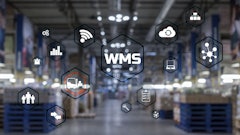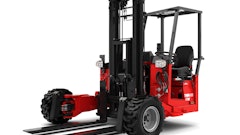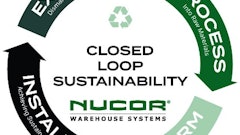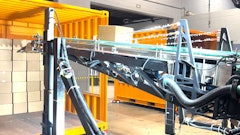
The electric vehicle (EV) market continues to grow and shows no signs of slowing down. Globally, the EV market is expected to jump from $105 billion in 2021 to $355 billion in 2028.1 And the number of EVs on the road is expected to increase from 16.5 million vehicles in 20212 to 125 million by 2030.3
One of the factors contributing to this growth is the passage of the Inflation Reduction Act in August 2022. And with California announcing a ban on new gas-powered cars by 2035 – with Maryland, Massachusetts, New Jersey, New York, Oregon, and Washington following their lead – EV sales in the U.S. will likely accelerate even further.
But as the EV market grows, so too have the challenges, especially as it relates to transporting the large format lithium-ion batteries that power EVs. The transport of new, used, prototype, damaged or end-of-life batteries (or cells) through the supply chain is a complicated and highly regulated process, and understanding the regulations and requirements is vital for every organization in the automotive industry. After all, in today’s ever-growing EV market, lithium battery shipping will be a ubiquitous part of the automotive supply chain.
What Makes Shipping Lithium Batteries So Difficult?
The risk associated with lithium batteries has been highly publicized. They are prone to “thermal runaway,” where a chain of events takes place to include a ballistic reaction followed by an immediate flame. As a result, they are classified as dangerous goods (DG)/hazardous materials (hazmat) and are subject to strict regulations that must be followed when shipping and handling them.
The rules and requirements for packaging and shipping lithium batteries can vary greatly depending on several factors, such as weight, dimension, power capacity, status, location, and more. Batteries with a watt-hour rating of greater than 300Wh, such as those used in EVs, are considered “fully regulated class 9 shipments,” and must comply with all hazmat regulations for packaging, labeling, documentation, training, and specified shipping methods.
Every transport mode requires compliance with a different set of regulations. This includes the 49 CFR for road and rail transport (in the U.S.), the IMDG code for vessel and maritime transport, and IATA Dangerous Goods Regulations (DGR) for air transport. Different countries may also have their own set of DG regulations that must be considered as well.
Large-scale and/or prototype lithium batteries over 35kg can require Special Permits (in the U.S.) or Competent Authority Approval (in Europe) for compliant air transport. Securing a Special Permit or CAA can be a time-consuming process that can bog down your operation if not handled efficiently.
Another regulatory body to consider is the Environmental Protection Agency (EPA). When shipping lithium batteries or cells for disposal or recycling, you must follow all proper EPA regulations, which may include environmental waste labeling (when shipping directly to a physical recycler) or – in some cases – hazardous material labeling and proper documentation. But keep in mind it’s not one or the other, it’s both: you must follow all proper regulations from the EPA and the DOT. Additional packaging changes may also be needed as well.
EV Batteries Require Special Packaging and Handling
Besides having to comply with complex regulations, the inherent characteristics of large format batteries present additional challenges when it comes to transportation, regardless of their condition. EV batteries are large and can weigh anywhere from 40kg to over 400kg, with each battery having its own design with different weight distribution points. This makes the physical handling of EV batteries challenging, and workers often need special training and equipment just to handle them.
Shippers must also comply with all packaging regulations. Unlike most automotive parts, large format lithium batteries often require custom packaging. To be compliant, this specialized packaging must be able to handle the size and weight of the battery being shipped while also passing all UN packaging group requirement testing standards.
Compliant packaging for large format lithium batteries also has numerous components and materials, and each of these must meet specific standards. For example, batteries that are considered damaged, defective, or recalled (DDR) must have inner packaging, the battery must be surrounded by cushioning material that is non-combustible, non-conductive and has sufficient absorbent material. Large format lithium battery packaging is often custom-designed and can include complex prototyping, constructing and testing processes.
Transporting DDR batteries adds a whole new level of complexity and challenges, and special packaging, special permits or global regulatory requirements may be needed.
Best Practices for Lithium Battery Transport
Whether it’s managing a large recall or the daily transport of smaller battery modules, shipping lithium batteries can be challenging. But there are steps you can take to simplify the process:
- Know the regulations that apply to your batteries. Many factors impact how lithium batteries are packaged and shipped. Consider the dimensions of the battery, the weight distribution, power capacity and battery status. Then be aware of the rules and regulations that govern transport (especially any shipping restrictions), including any variations between country or transportation mode and any carrier or company-specific rules, and ensure you have the proper processes and infrastructure in place to maintain compliance across the supply chain.
- Consult an expert. The best way to make sure all aspects of large format lithium battery transport are covered is to find a partner who’s done it all before. A trusted partner can help you understand and navigate every facet of the lithium battery journey – from understanding the latest regulations and the packaging process, to transport, training, and managing DDR batteries. Don’t discount the value of taking that burden off the internal team. A partner can also assist in evaluating whether the batteries can be reused or recycled.
- Establish strong partnerships. Most large-format lithium battery transportation involves more than two parties. In some cases, such as during a recall, you might have to rely on several supply chain partners to execute various stages of a battery’s journey, including battery manufacturers, automotive manufacturers, distributors, logistics providers, recyclers, carriers and more. And for the operation to be completed on schedule, those partners must be always on the same page.
- Ensure proper training. Training matters, especially when it comes to fully regulated shipping. Anyone with any part in shipping DG is considered a hazmat employee and must be 49 CFR trained and certified on every aspect of shipping – from filling out the bill of lading to physically loading the freight. Online, interactive and 3D training can be incredibly useful in helping employees digest complicated DG compliance and shipping regulations in a more convenient, interesting, and memorable format.
Keeping up with EV Market Growth
As the lithium battery market continues to grow, understanding and managing transport becomes increasingly critical. From large recalls to ongoing, daily transport, regulatory compliance, proper packaging, and correct shipping processes – regardless of battery status – requires time and resources that some companies may not have. Being proactive is key. Companies in the automotive industry should proactively take steps to ensure that lithium-ion batteries are transported safely and compliantly.


























